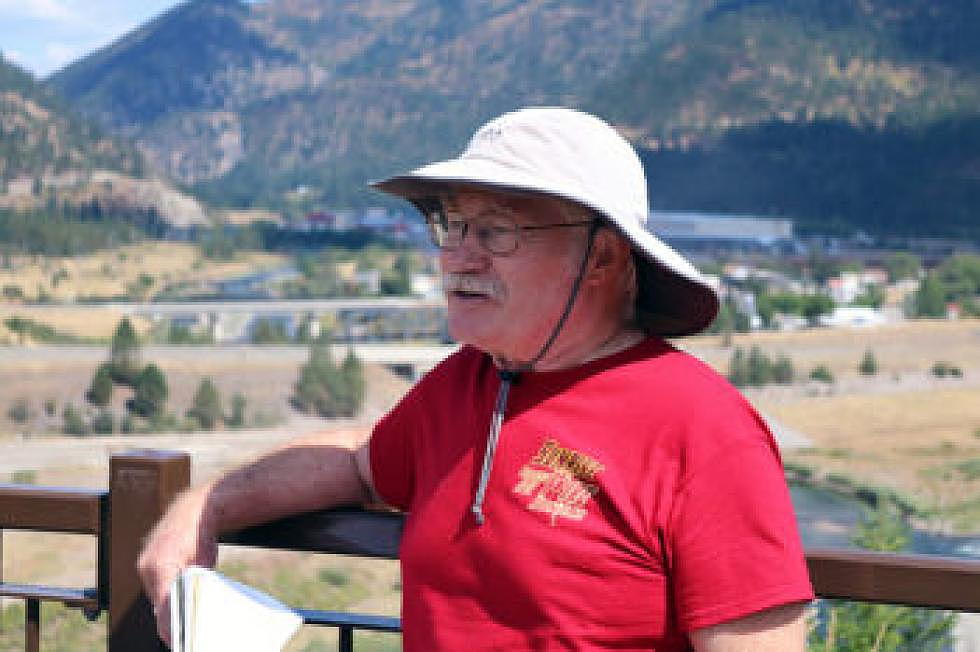
Climate, health activists decry proposed cuts to EPA as summers fill with smoke
John Woodland arrived at the Black Cat fire just before midnight back in 2006. The former Superior fire chief had joined other members of his department to witness something he hasn't since forgotten.
Something he says speaks to the future.
“I remember standing at the staging area, waiting for a specific assignment with a couple other firefighters,” he said. “We're watching a running crown fire go up through the trees, thinking that doesn't happen to fires at 11:30 at night.”
Woodland, who now serves as a member of Montana 350, joined a handful of local and regional officials earlier this month to discuss the effects of climate change, the impacts of President Donald Trump's budget on the U.S. Environmental Protection Agency, and the future of fire and Superfund projects in Montana.
Standing above the Clark Fork River on a rare clear day, Woodland offered more than one account of the unusual fire activity he witnessed over his career as chief of the rural department.
In 2013, a grass fire near Superior grew to become the larger West Mullan fire. While there was nothing unusual about the fire itself, Woodland said, the early start date of July 14 was alarming.
“It's what we once thought of as 'before the fire season,' so we were able to get a lot of resources quickly,” Woodland said. “But we've reached a point now where that's no longer what you can look at as being before the beginning of the fire season.”
Over the past year, researchers at the Montana Climate Office at the University of Montana have said more than once that emerging climate models suggest temperatures across the state will increase nearly 6 degrees by 2050.
Average annual temperatures, both globally and in Montana, have slowly increased in each of the past few years. The projections also call for drier summers and 30 additional days with temperatures over 90 degrees.
While the consequences could lead to the extinction of several species and radically change the state's forest landscape, they may also result in longer fire seasons. And that means future summers with poor air quality and reduced public health, much like the summer of 2017.
“I haven't been able to look outside without a mask or clean air for several weeks,” said Woodland. “It's reaching the point that even with a filter system on the house, the inside of the house is starting to smell smoky.”
Given the health consequences of perpetually smoky air, environmental and health advocates say it's the wrong time for President Trump to slash the U.S. Environmental Protection Agency's budget.
As proposed, Trump aims to cut the EPA by 31 percent and eliminate 15,000 agency employees, representing roughly one quarter of the workforce. Opponents, which now include Rep. Greg Gianforte, contend that such cuts would have a lasting and devastating impacts on public health, environmental cleanup and local economies.
“A lot of good things are at risk,” said Jan Hoem, a member of the Missoula City-County Air Quality Advisory Council. “Many of Missoula's air quality programs are partially federally funded, and they will be slashed.”
Clean air programs protect an estimated 76,000 asthmatic adults and 16,000 children in Montana – those who are most susceptible to smoky summer days and factory pollutants.
Paul Smith, who serves as director of pediatric care and pulmonary services at Community Medical Center, said failing to regulate air quality would impact public health, costing taxpayers more money down the road.
“It's no secret that the present administration and EPA are aggressively rolling back regulations on air and water pollution,” Smith said. “They say it will more fairly balance the cost to industry and the economy. But what they don’t say is that it comes with healthcare costs and lost lives, especially for children who are nowhere on their balance sheets.”
While Trump has emerged as a denier of climate change, Smith said it's harder to dispute that air pollution increases disease. Among the problems, he names asthma, pneumonia, premature birth and heart disease.
When air pollution increases, he adds, public health worsens. One estimate by the World Health Organization suggests that air pollution alone costs the U.S. more than $200 billion a year in health care.
“We’ve seen firsthand in Montana that forest fires are more frequent, start sooner and last longer,” said Smith. “That trend has been increasing for over half a century, and it will continue. While air pollution affects us all, infants and children are damaged disproportionately because, per pound, they breathe more air.”
While the Western U.S. saw an average of 14 large fires per year between 1980 and 1989, that has since grown to 19.2 major fires per year, according to Woodland. The length of the fire season has grown from five months to seven.
Woodland believes the trends are now evident across Montana. Consider this year's fire season. More than a dozen large-scale fires broke out before mid-July, including the July fire, which started as early as July 3.
By July 14, more than 10 other fires had taken hold, including the Lolo Peak fire, prompting the state to declare a fire emergency at one of the earliest points in memory.
“Smoke is certainly an index of pollutants and we don't know of any safe levels,” Smith said. “The higher the exposure, the worse the lung damage. There's no real safe level of particulate.”
Hoem agreed, saying it was the wrong time to hinder the EPA's ability to do its job.
“I have watched, not silently, over the past seven months as President Trump systematically worked to dismantle protections that have been working for decades for our families' health and our planet,” said Hoem. “If these budget rollbacks go through, this period could be the Love Canal in the making.”
